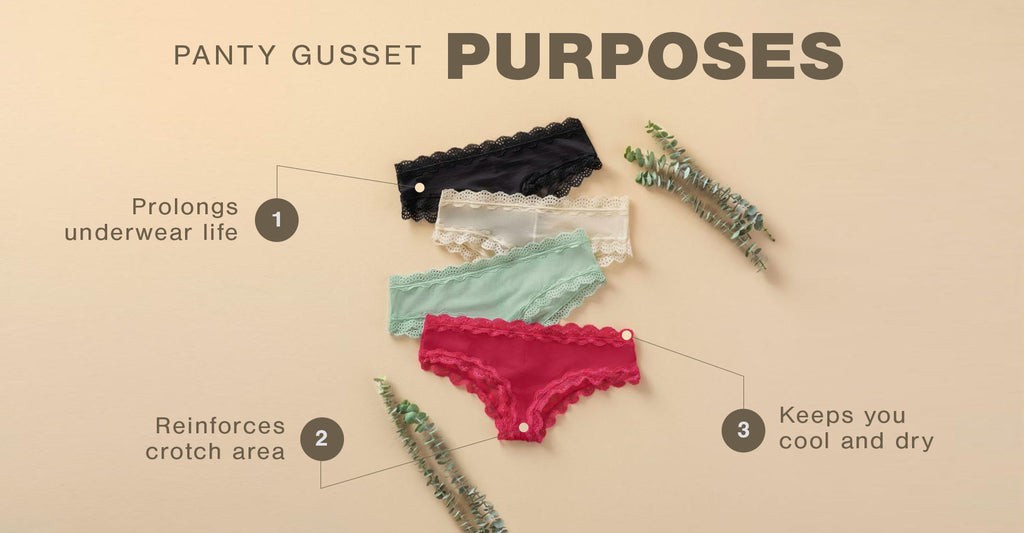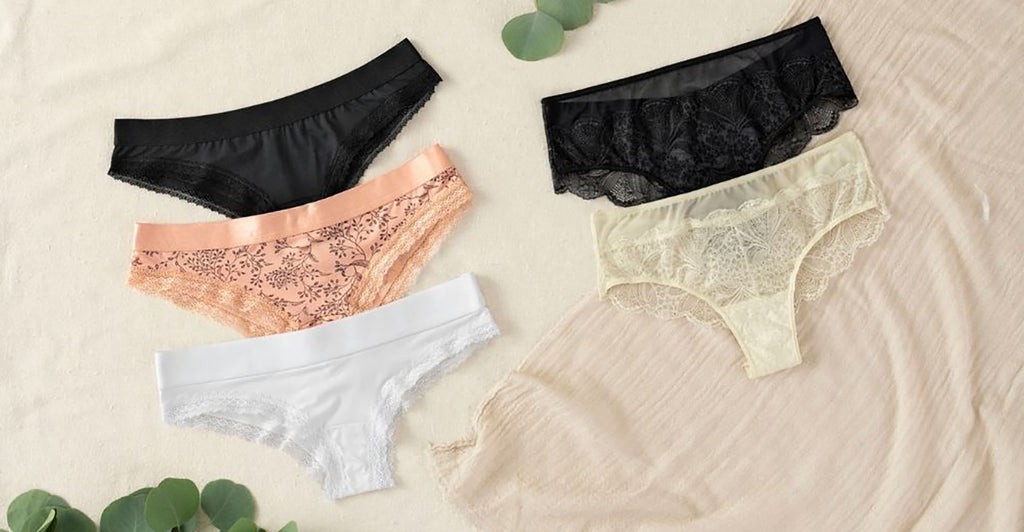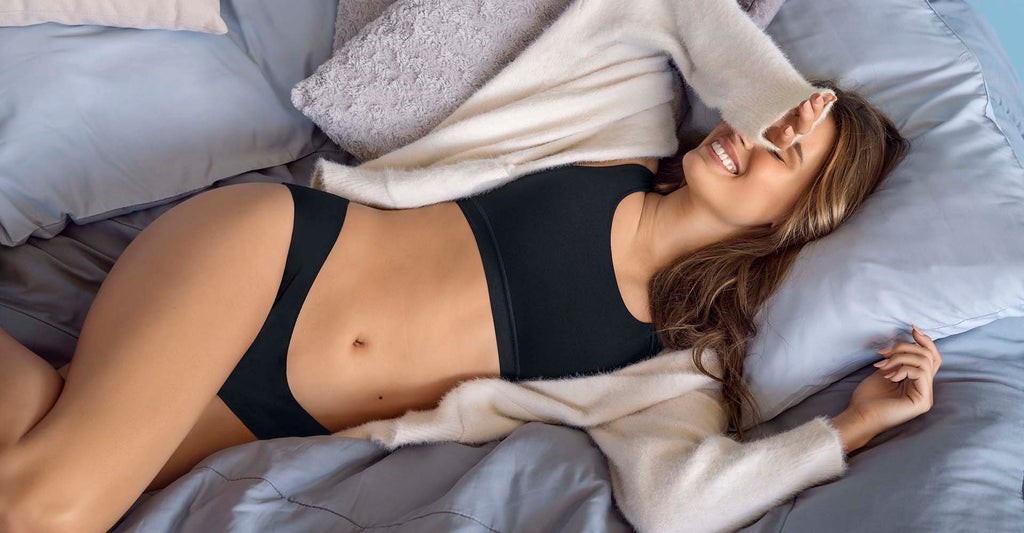Why do women’s underwear have a pocket? The extra layer of fabric, known as a gusset, serves multiple crucial purposes for hygiene and comfort. At WHY.EDU.VN, we break down the significance of this design feature, offering solutions to keep you informed and comfortable with functional undergarments, breathability and support. We clarify the purpose, types, and importance of gussets, helping you make informed choices.
1. Defining the Panty Gusset: What Is It?
A panty gusset is an extra layer of fabric sewn into the crotch area of women’s underwear. According to Merriam-Webster, a gusset is “a usually diamond-shaped or triangular insert in a seam to provide expansion or reinforcement.” While men’s underwear can have gussets, they are more prevalent in women’s panties. Gussets are found in various types of women’s underwear, including boyshorts, bikini panties, and thongs.
The primary role of a gusset is to enhance comfort and hygiene. It can be sewn closed on both sides or left open on one end, creating a pocket-like structure. Contrary to any storage assumptions, these gussets serve a more critical function.
2. Multiple Benefits: Why Panty Gussets Matter
Panty gussets offer several key benefits, enhancing the functionality and comfort of women’s underwear.
- Reinforcement: The gusset reinforces the crotch area, typically the narrowest part of the underwear, extending its lifespan.
- Absorption: It helps absorb discharge, sweat, and other fluids, keeping you dry and comfortable.
- Leakage Prevention: A panty gusset prevents discharge from leaking through your underwear and staining your clothing.
3. Enhancing Breathability: The Role of Cotton Gussets
Many women’s panties are made from synthetic materials like nylon, polyester, and spandex. While these materials offer stretch, they are not very breathable compared to cotton. The cotton gusset allows for better ventilation, reducing the risk of trapped sweat and bacteria.
The inclusion of a cotton gusset in synthetic underwear helps prevent:
- Skin Irritations: Reduces the risk of skin irritation.
- Bacterial Infections: Lowers the likelihood of bacterial infections.
- Yeast Infections: Decreases the chance of developing yeast infections.
This is why lacy or sheer underwear often has a solid cotton gusset in the crotch.
4. Comfort and Cushioning: Enhancing Wearability
A gusset improves the comfort of wearing underwear. It cushions sensitive areas, preventing rubbing and irritation throughout the day. Properly sewn gussets are virtually undetectable, enhancing overall comfort. Many individuals actively seek underwear with gussets for these reasons.
5. Open vs. Closed Gussets: What’s the Difference?
Panty gussets can be sewn closed on both ends or left open on one side. Open-ended gussets are not designed for storage. The primary distinctions lie in manufacturing efficiency and potential benefits.
- Closed Gussets: These are sewn on both ends, providing extra reinforcement and a clean finish. Brands like Leonisa often use closed gussets for added durability.
- Open Gussets: Leaving one end open can reduce material usage and production costs, making the underwear more affordable. However, the open flap might catch on things or unravel over time.
Ultimately, the presence of a gusset is more important than whether it is open or closed.
6. Gusset-less Panties: Why Some Underwear Lack This Feature
While most women’s panties include a gusset, some do not. This absence can be attributed to several factors:
- Material Composition: Underwear made entirely of cotton may not require a gusset, as cotton is naturally breathable.
- Seamless Design: Seamless underwear styles often lack a traditional gusset to maintain a smooth, seam-free fit.
- Lingerie: Certain lingerie styles, particularly those made of lace or sheer materials, may omit the gusset for aesthetic reasons.
7. Material Matters: Choosing the Right Fabric
The fabric of your underwear significantly impacts comfort and hygiene. Here’s why different materials matter:
- Cotton: Highly breathable and absorbent, ideal for everyday wear.
- Synthetic Fabrics (Nylon, Polyester, Spandex): Offer stretch and a smooth fit but are less breathable. A cotton gusset can compensate for this.
- Lace and Sheer Materials: Often used in lingerie, these fabrics are typically less breathable and best suited for short-term wear.
8. Seamless Underwear: Weighing Comfort and Function
Seamless underwear prioritizes comfort by minimizing seams, which can reduce the need for a traditional gusset.
However, it’s important to carefully check the product description and pictures to ensure that seamless panties made of synthetic fabrics have a gusset. If not, consider limiting their use to short periods.
9. Lingerie Considerations: Balancing Style and Health
Lingerie, especially lace or sheer underwear, often lacks gussets to enhance its aesthetic appeal. While these styles are suitable for special occasions, they should not be worn for extended periods due to the lack of breathability. Synthetic lingerie without a gusset can trap moisture and increase the risk of irritation and infections.
10. Practical Tips: How to Choose Underwear with a Gusset
When shopping for underwear, consider the following tips to ensure you choose options with a gusset:
- Read Product Descriptions: Look for mentions of a gusset or an extra layer of fabric in the crotch.
- Examine Product Photos: Check the images closely to see if a gusset is visible.
- Check Material Composition: Opt for cotton or underwear with a cotton gusset, especially if made of synthetic materials.
- Consider the Style: Be mindful of seamless and lingerie styles, which may lack a gusset.
- Feel the Fabric: If possible, feel the fabric to assess its breathability and comfort.
11. What Are The Various Types of Gussets?
Different types of gussets serve specific purposes based on their design and placement. Here’s a breakdown:
| Type of Gusset | Description | Common Uses |
|---|---|---|
| Diamond Gusset | Diamond-shaped fabric inserted at the crotch for added mobility and reinforcement. | Athletic wear, pants, and garments requiring a wide range of motion. |
| Triangular Gusset | Triangular fabric providing extra space and strength in the crotch area. | Jeans, trousers, and other everyday wear. |
| Inseam Gusset | Additional fabric panel along the inseam to prevent wear and tear. | High-stress areas like workwear and durable pants. |
| Underarm Gusset | Small fabric piece under the arm to allow for greater arm movement. | Jackets, shirts, and activewear requiring flexibility. |
| Panty Gusset | Extra layer of fabric in the crotch of underwear for hygiene and comfort. | Women’s underwear to enhance breathability, absorbency, and prevent skin irritation. |
| Open or Closed End Gusset | Open at one or both ends vs stitched close | Women’s underwear, the open version can save on materials and production costs. |



12. How Does The Gusset Impact The Comfort of Women’s Underwear?
The gusset significantly enhances the comfort of women’s underwear by:
- Providing Breathability: Cotton gussets allow for airflow, reducing moisture and preventing bacterial growth.
- Enhancing Absorbency: The extra layer of fabric helps absorb discharge and sweat, keeping the wearer dry.
- Reducing Friction: By creating a smooth, cushioned layer, the gusset minimizes rubbing and irritation against sensitive skin.
- Preventing Irritation: High-quality gussets made from soft, hypoallergenic materials can prevent allergic reactions and chafing.
13. What Materials Are Commonly Used For Gussets, and Why?
Common materials used for gussets include:
- Cotton: Preferred for its breathability, absorbency, and softness, making it ideal for direct contact with the skin.
- According to a study by the National Cotton Council, cotton’s natural fibers allow for better air circulation, reducing moisture buildup and the risk of infections.
- Bamboo: A sustainable option that is naturally antibacterial, moisture-wicking, and gentle on the skin.
- Microfiber: Offers a smooth, soft feel and excellent moisture-wicking properties, though less breathable than cotton.
- Silk: Luxurious and hypoallergenic but less absorbent and requires more delicate care.
14. The History of Gussets
Gussets have a rich history, evolving from practical necessities to modern design features.
- Early Uses: Gussets were initially used in garments to provide structural support and flexibility. In medieval clothing, gussets were strategically placed in areas like armpits and crotches to allow for a wider range of motion.
- Industrial Revolution: With the advent of mass production, gussets became more standardized. They were incorporated into workwear to enhance durability and comfort, particularly in trousers and shirts.
- Modern Era: Today, gussets are used in various types of clothing, from high-fashion pieces to athletic wear. Their role has expanded to include aesthetic elements, such as decorative gussets that add visual interest. In underwear, gussets have become synonymous with hygiene and comfort.
15. Gussets In Other Types of Clothing?
Gussets aren’t limited to just underwear. They’re versatile additions found in various types of clothing, each serving a unique purpose.
- Pants and Trousers: Gussets in the crotch area of pants and trousers provide extra room and flexibility, preventing tears and enhancing comfort during movement.
- Shirts and Blouses: Underarm gussets in shirts and blouses allow for a greater range of motion, reducing strain on the fabric and preventing underarm bunching.
- Jackets and Coats: Gussets in the shoulders and back of jackets and coats improve mobility, making them more comfortable for activities like driving or hiking.
- Athletic Wear: In sports apparel, gussets are strategically placed to enhance flexibility and prevent chafing during intense physical activities.
- Shoes and Boots: Gussets in footwear provide a snug yet flexible fit, accommodating different foot shapes and preventing discomfort.
16. How Do You Care for Underwear with Gussets to Prolong Their Life?
Proper care can extend the life of underwear with gussets.
- Washing: Wash underwear in cold water using a gentle detergent. Avoid bleach, which can damage the fabric and elastic.
- A study by the American Cleaning Institute recommends washing delicate items in a mesh laundry bag to prevent snagging and stretching.
- Drying: Tumble dry on low heat or, ideally, air dry. High heat can degrade elastic and fabric fibers.
- Storage: Store underwear in a clean, dry drawer. Fold or roll them to prevent creases and maintain their shape.
- Rotation: Rotate your underwear collection to ensure each pair gets adequate rest, preventing over-wear and tear.
- Avoid Harsh Chemicals: Steer clear of harsh chemicals and fabric softeners, which can break down fibers and reduce absorbency.
17. What Certifications Should You Look For When Buying Underwear With Gussets?
When purchasing underwear with gussets, look for certifications that indicate quality and safety.
| Certification | What It Signifies | Why It Matters |
|---|---|---|
| Oeko-Tex Standard 100 | Tests for harmful substances in textiles. | Ensures the fabric is safe for skin contact and free from allergens. |
| GOTS (Global Organic Textile Standard) | Certifies that the fabric is made from organic fibers. | Guarantees environmentally friendly production and fair labor practices. |
| Fair Trade Certified | Ensures fair wages and safe working conditions for garment workers. | Supports ethical production and sustainable communities. |
| BCI (Better Cotton Initiative) | Promotes sustainable cotton farming practices. | Reduces the environmental impact of cotton production and improves farmers’ livelihoods. |
| USDA Organic | Certifies that the cotton is grown without synthetic pesticides or fertilizers. | Ensures the cotton is free from harmful chemicals and supports organic farming practices. |
18. What Are Some Common Misconceptions About Gussets?
Several misconceptions surround gussets, leading to confusion about their purpose and benefits.
- Gussets are only for hygiene: While hygiene is a key benefit, gussets also enhance comfort and durability.
- Open-ended gussets are for storage: Open gussets are not designed to hold items. The opening is often a result of manufacturing efficiency.
- All underwear needs a gusset: While highly beneficial, underwear made entirely of breathable materials like cotton may not require a gusset.
- Gussets are uncomfortable: A well-designed gusset should be virtually undetectable and enhance overall comfort.
- Synthetic gussets are as good as cotton: Synthetic materials may lack the breathability and absorbency of cotton, making cotton gussets preferable.
19. Do Gussets Help With Odor Control?
Yes, gussets play a role in odor control.
- Moisture Absorption: Gussets, particularly those made of cotton, help absorb moisture from sweat and discharge, reducing the environment in which odor-causing bacteria thrive.
- Breathability: The breathable nature of cotton gussets allows for better ventilation, preventing the buildup of moisture and odors.
- Quick Drying: Moisture-wicking materials in gussets help keep the area dry, minimizing the chances of odor development.
20. What Innovations Are Being Made In Gusset Design and Materials?
Innovations in gusset design and materials are continually emerging to enhance comfort, hygiene, and sustainability.
- Advanced Moisture-Wicking Fabrics: New synthetic blends offer superior moisture-wicking capabilities, keeping the area drier for longer.
- Antimicrobial Treatments: Gussets treated with antimicrobial agents inhibit the growth of bacteria and fungi, reducing odors and preventing infections.
- Seamless Gussets: Innovations in seamless technology allow for the creation of gussets without stitching, enhancing comfort and reducing irritation.
- Biodegradable Materials: Sustainable materials like Tencel and organic cotton are gaining popularity, offering eco-friendly alternatives to traditional fabrics.
- Adaptive Designs: Gussets with adaptive designs contour to the body for a more personalized and comfortable fit.
21. FAQ About Women’s Underwear Gussets
Here are some frequently asked questions about gussets in women’s underwear:
- What is the purpose of a gusset in underwear?
A gusset enhances comfort, breathability, absorbency, and hygiene in the crotch area. - Why are some gussets left open at one end?
Open-ended gussets can reduce material costs during manufacturing. - Are gussets necessary in all types of underwear?
While beneficial, gussets may not be necessary for underwear made of highly breathable materials like cotton. - How do I choose underwear with a good gusset?
Look for cotton gussets, read product descriptions, and check for certifications like Oeko-Tex. - Can gussets help prevent infections?
Yes, by providing breathability and absorbing moisture, gussets can reduce the risk of bacterial and yeast infections. - What materials are best for gussets?
Cotton is generally preferred for its breathability and absorbency. - Do seamless underwear styles have gussets?
Some seamless styles do, but it’s important to check the product description. - How should I care for underwear with gussets?
Wash in cold water, avoid bleach, and air dry when possible. - Are there eco-friendly gusset options?
Yes, look for gussets made from organic cotton, bamboo, or other sustainable materials. - Do gussets help with odor control?
Yes, by absorbing moisture and promoting breathability, gussets can help reduce odor.
Understanding the function and importance of panty gussets empowers you to make informed decisions when choosing underwear. By prioritizing comfort, hygiene, and quality, you can enhance your overall well-being.
At WHY.EDU.VN, we understand the importance of reliable information. That’s why we’re committed to providing detailed, expert-backed answers to all your questions.
Still curious? Have more questions about underwear, fabrics, or anything else? Visit WHY.EDU.VN today! Our experts are ready to provide the answers you need.
Contact Us:
Address: 101 Curiosity Lane, Answer Town, CA 90210, United States
WhatsApp: +1 (213) 555-0101
Website: WHY.EDU.VN
Let why.edu.vn be your trusted source for answers. We’re here to satisfy your curiosity and provide the expert knowledge you deserve.